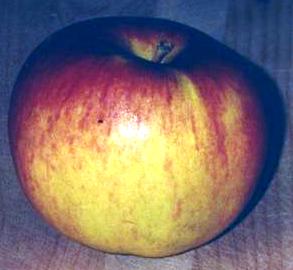Apples
The apple is said to have originated around Asia Minor. The first edible apple was cultivated around 1200 BC near Alma Ata in Kazakhstan. The Greeks and Romans were cultivating the apple by 300 BC. The European settlers brought it to America.
The apple came to the America’s around 1620. There is an old American legend of Johnny Appleseed. John Chapman was a settler in Leominster, Massachusetts. He used to distribute apple seeds to European settlers in Indiana, Ohio and Illinois.
The apple has a lot of symbolism. It could possibly be the forbidden fruit in the Garden of Eden. The apple is a symbol of feminism, and is associated to Venus de Milo. The apple is also the fruit of knowledge. (It is while school children give the apple to their teachers, in exchange for knowledge.)
The apple has been cultivated for at least 3,000 years. There are approximately 7,000 varieties of apples, but only about 20 are commercially significant to the United States.
Apples grow on trees. The tree produces white to pink blossoms. It takes 6 to 8 years for a tree to bear fruit. The apples contain 5 seed pods, or carpels.
The age of the apple tree determines the number of seeds in each pod. The apple is 20% air, therefore it floats in water. (Bobbing for apples…..) The dried up fuzzy end of the apple is called a sepal. Apples contain iron, so when they are cut, they tend to oxidize quickly and turn brown. To prevent oxidizing, combine with an acid. Keep apples away from ethylene sensitive products. (bananas in particular)
Apple color ranges from yellow to green to red. The texture ranges from tender to crisp. Their flavors can be anywhere from sweet to tart.
Apple production is leading in the states of Washington and New York. China is the top producer worldwide, and America is second. Apple trees thrive better when near other apple trees. The trees need a temperate climate to produce. It requires a cold, dormancy to survive. Apple orchids tend to do well on hills with well drainage. They do not require an extensive amount of water. Apples are available year round, but their peak season is from September to November.
Apples are almost always harvested before they are ripe. That will help withstand shipping and marketing. 50% of all apples produced are used for fresh fruit consumption, 20% go into processed apple products, 17% go into applesauce and pies, and 13% are exported.
Apples can be eaten raw out of hand, or any method of cooking and preparing. Cooking apples will disintegrate into a puree when cooked, and will not taste mealy. Apples can also be used to make cider, or Calvados, an apple brandy. Apple cider is fermented apple juice. Apples that are to be eaten out of hand need to be firm, juicy, tasty, and crisp. Apples for pies should be drier with slight acidity. Apple for baking must be sweet, and should not disintegrate easily. Jelly apples should be barely ripe. They need acid, and should be juicy, and high in pectin. Apples to be made into applesauce should not discolor easily.
Apples contain a high proportion of pectin- which is a type of carbohydrate found in many fruits. It produces a thickening quality that is used in jellies and jams.
Dishes that use apples are commonly referred to as a la Normande.
Look for apples that are firm with no blemishes or wrinkles. Apples are a good source of vitamins A and C, iron and are heavy in fiber. Apples contain pectin, a natural thickening agent. It is a diuretic, laxative, anti-diarrheal, muscle tonic, anti-rheumatic, stomachic, and is beneficial for the digestive system. Eating raw apples help cleanse the teeth and massage the gums. The high iron content under the skin brought about the old saying:
“An apple a day, keeps the doctor away.”
What goes good with Apples??
Apple’s Affinities
applejack oranges
bacon pears
blackberries pepper, black
blue cheese pignoli
brandy pistachios
brown sugar praline
butter prunes
butterscotch quinces
Calvados raisins
caramel rosemary
cassia rum
celery sauerkraut
cheese sausages
chestnuts sherry
cider sour cream
cinnamon sugar
cloves vanilla
Cognac vermouth
Cointreau vinegar
coriander walnuts
cranberries wine, red
cream yogurt
currants, black custard
dates ginger
Grand Marnier hazelnuts
honey horseradish
Kirsch lemon
Madeira maple syrup
molasses nutmeg
nuts, esp. almonds or pecans
In French: pomme (pOm)
In Spanish: manazana (man-zan-a)
In Italian: mela (meel-ya)
 Akane
Akane  Arkansas Black
Arkansas Black  Black Twigg (has a thick fuzzy skin)
Black Twigg (has a thick fuzzy skin)
 Cameo
Cameo  Clayville Blanc
Clayville Blanc  Golden Delicous
Golden Delicous  Red Delicous
Red Delicous  Early Gift
Early Gift  Empire
Empire  Fuiji
Fuiji  Gala
Gala  Ginger Gold
Ginger Gold  Granny Smith
Granny Smith  Red Gravenstein
Red Gravenstein  Gravenstein
Gravenstein  Jonathon
Jonathon  McInstosh
McInstosh  Mutsu
Mutsu  Pink Lady
Pink Lady  Pink Pearl
Pink Pearl  Rome
Rome  Scott’s Orange Pippin
Scott’s Orange Pippin  Sierra Beauty
Sierra Beauty  Winter Banana
Winter Banana
Originally Published 10-13-11
© 2011 Chef Jennifer M. Denlinger All rights reserved
Please contact me for permission to use or reference this work.
Please contact me if you wish to receive “Food For Thought” in your mailbox.
